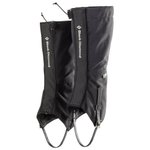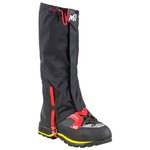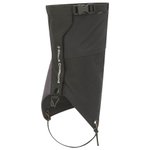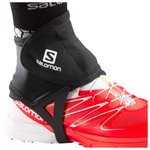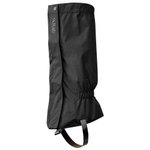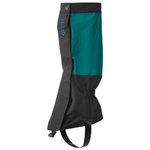Snow gaiters
What gaiters to choose for winter time hikes?
At Glisshop we offer various models of gaiters suited to all activities. You will find the necessary equipment for snowshoes or simply to complete your ski equipment. Technically, mountain gaiters cover the bottom of the pants and the upper of the shoe to ensure perfect waterproofness. Hiking gaiters, the most efficient ones, hook on the shoe laces and feature a strap that goes under the sole. Simply do not forget to put the buckles on the outside to avoid getting your feet caught in them while walking. Whether you are looking for a classic model, a Gore-Tex gaiter or a mountaineering gaiter, you should find the right product among our selection.
Read more Show less

-
Recommended price
£65.16
-29%
£46.02
Ideal for ice climbing, the Black Diamond Frontpoint GTX Black Gore Tex gaiters are perfectly protective
- S
- M
- L
- XL


-
£52.11
Very useful for snowshoeing, the Millet Alpine Gaiters Dryedge prevent powder from entering your boots, protecting you from the cold and damp
- L


-
Recommended price
£52.11
-28%
£37.32
-
- S
- M
- L


-
£39.06
Salomon Trail Gaiters High Black protect your feet from debris and offer elastic comfort with a convenient Velcro closure.
- S (36 2/3 - 40)
- M (40 2/3 - 42 2/3)
- L (43 1/3 - 46 2/3)


-
£34.71
Salomon Trail Gaiters Low Black protect your feet from debris and mud, while offering a comfortable, elastic fit thanks to their Velcro fastening.
- S (36 2/3 - 40)
- M (40 2/3 - 42 2/3)
- L (43 1/3 - 46 2/3)


-
£47.76
The Trek Gaiter Black from RAB is a gaiter that will protect you during all your mountain expeditions.
- M


-
Recommended price
£47.76
-9%
£43.41
The Trek Gaiter Wmns Atlantis from RAB is a women's gaiter offering great protection against all the elements.
- L
Loading...
Why wear gaiters when hiking?
Gaiters effectively protect the lower legs and the tops of your shoes. They prevent water, snow, sand, and pebbles from getting in, reducing the risk of blisters and helping keep your feet dry for longer. They also shield the lower part of your trousers from dirt, abrasion, and moisture, while providing an extra barrier against ticks, brambles, or superficial scratches. In wet or snowy conditions, they offer real added value for hiking.
A versatile option for hikers
Hiking gaiters are suited to a wide range of terrains and conditions. They’re useful in wet or muddy environments, tall grass, forests, sandy areas, or even in the mountains. They’re just as suitable for summer hikes as they are for winter outings, with or without snowshoes. Some hikers wear them with shorts to keep their feet dry while staying lightweight. Others pair them with waterproof trousers or hiking shoes, especially low-cut models, for enhanced protection.
Waterproof and breathable gaiters protect your feet from the rain
Most hiking gaiters are designed to stop water entering through the top of your shoes — a common issue in rain, wet vegetation, or puddles. Breathable models made from technical fabrics like Gore-Tex allow perspiration to escape while blocking external moisture, which prevents a build-up of dampness inside and improves comfort on long walks.
Extra protection for mountaineering
In mountaineering, gaiters are used in more technical conditions: snowfields, hard snow, sharp rocks, and steep slopes. They protect your legs and trousers from abrasion while stopping snow from entering, even in inclined positions. They need to stay securely in place, including over the tops of your boots, using sturdy fastening systems, often reinforced, with covered zips or high-quality Velcro closures.
How to put gaiters on hiking boots
Gaiters are worn over your trousers. They cover the top of your boots and are secured using a hook for the laces, a strap under the sole, and a front or side closure system (Velcro, press stud, zip, or drawcord depending on the model). It's important to position the buckles on the outside to avoid snagging while walking. The fit should be snug but not overly tight, ensuring both waterproofness and freedom of movement.
How to choose the right gaiters
Choosing gaiters depends mainly on the activity, outing duration, and expected conditions. There are different types of gaiters suited to various terrains, seasons, and protection needs. Here are the main gaiter types based on use:
Hiking gaiters
Hiking gaiters come in long (up to the knee) and short (above the ankle) versions. Long gaiters are best for muddy, wet terrain or tall grass. Short ones are suited to dry paths or summer hikes with low-cut shoes. Durability also varies: some models are lightweight and thin, others are more robust and reinforced. The materials used — such as ripstop nylon or waterproof-breathable membranes — affect both comfort and durability.
Mountaineering gaiters
Stiffer and more rugged, mountaineering gaiters are designed for use in demanding environments with snow, ice, or abrasive rock. They must be very durable and fit tightly so they don’t shift — even when wearing crampons. Fixings are strong, with reinforced underfoot straps, secure hooks for laces, and reliable closures (zips or Velcro). Some models are extra tall to offer protection up to the knee.
Trail running gaiters
For trail running, gaiters are mainly used to keep debris (sand, gravel, twigs) out of your shoes. They are lightweight, low-profile, breathable, and easy to put on, often using elastic or Velcro fastenings. Their purpose is to act as a barrier without interfering with your stride. Waterproofness is generally less important for this use.
Snowshoe gaiters
Snowshoeing often involves walking through powder or wet snow. Long hiking gaiters are ideal for this activity, preventing snow from entering your footwear and keeping the bottom of your trousers dry. Waterproofness is crucial here, as is a good grip on the boot. Abrasion resistance is also valuable, though the technical demands are lower than in mountaineering.

